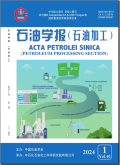ELUCIDATION OF HYDRODESULFURIZATION AND HYDROGENATION MECHANISMS USING RADIOISOTOPE TRACER METHODS
To meet the specification of sulfur and aromatic contents in diesel fuel, it is necessary for refiners to develop a new catalyst with high activity of hydrodesulfurization and hydrogenation. In the present study, the properties of noble metal catalysts for hydrodesulfurization and hydrogenation in the presence of sulfur compounds have been investigated. The hydrogenation activity of phenanthrene (PHE) on single noble metal and double noble metal catalysts—Pt/Al2O3, Pd/Al2O3 and Pd-Pt/Al2O3 in the presence of dibenzothiophene (DBT) was perforrned in a fixed bed flow reactor. The Pt based catalysts revealed the similar HDS activities and higher HYD activity compared with convertional Mo based ca-talysts. The maximum activity was obtained around 320 ℃ for both catalyst types. The Pt based catalysts produced perhydrophenanthrene as a major product at the maximum activity in the hydrogenation of PHE while the Mo based catalysts produced octahydrophenanthrene. A 35S radioisotope pulse tracer method (35S RPTM) was used to estimate the behavior of sulfur on the working catalysts and to clarity the differences between Pt and Mo based catalysts. Very little amount of labile sulfur was accumulated on the Pt and Pd catalysts in the HDS of [35S]DBT (PtS0.25 or PdS0.25). This indicates that the mechanism of DBT HDS on noble metal catalysts is significantly different from that on conventional Mo based catalysts where Mo is present as MoS2 less than 60% of which can be labile in the case of Co-Mo/Al2O3. Another Ru-Cs/Al2O3 catalysts were also prepared and the behavior of sulfur on the working catalyst was compared with those of Mo based catalysts and Pt and Pd catalysts. The values of labile sulfur in the HDS reaction for Ru-Cs catalysts approximately correspond to RuS0.5-0.74. These amounts of labile sulfur are much higher than those for Pt and Pd catalysts. The result suggests that the oxidation state of Ru species is present between the oxidation states of Pt or Pd and Mo, and can change in the wide range during the HDS reaction, different from PtS0.25 (PdS0.25) and MoS2 which is unchangeable under the usual HDS conditions. From the approach of using [35S]H2S it was found that the labile sulfur was hardly formed during the presulfiding procedure but was formed only during the actual HDS. This is also a unique character of Ru catalysts.
metal catalysts、noble metal、Pt and Pd、sulfur compounds、the differences、oxidation state、diesel fuel、fixed bed
17
TE6(石油、天然气加工工业)
2004-01-08(万方平台首次上网日期,不代表论文的发表时间)
共7页
18-24








